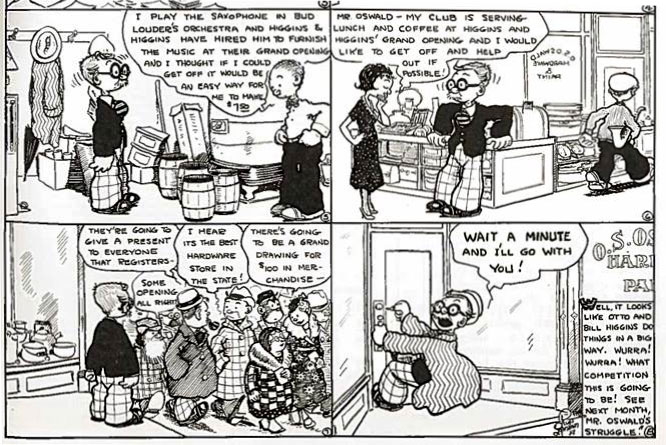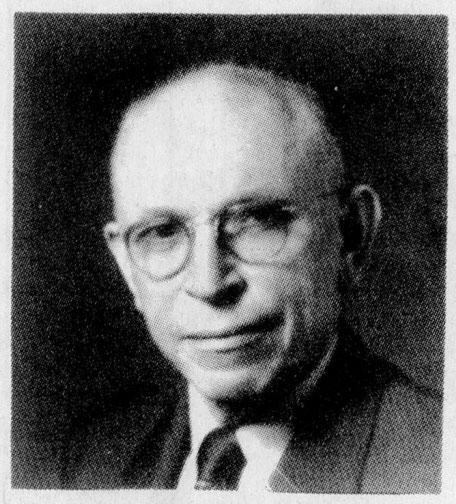Russ Johnson was an American comic artist, best-known as the creator of 'Mister Oswald' (1927-1989), a comic strip which ran for six decades in the nationally syndicated trade magazine Hardware Retailing. Set in a little hardware store, it features the daily problems of an unlucky store owner, his employees, the salespeople and the customers. A gentle, old-fashioned comic strip, much of its charm comes from its recognizability. Johnson drew every background and object with intricate detail. Running for more than half a century, 'Mr. Oswald' is a time capsule of how stores evolved over the course of six decades. Modern-day readers can also delight in the charming observational comedy which, even today, remains recognizable to anyone who ever ran, worked in or visited a hardware shop. Together with Australian cartoonist Jim Russell, Johnson is also the longest-known continuously active comic artist of all time, both working a record-breaking 62 years (!) without interruption! Yet since he mostly worked for a small niche magazine, both his fame and record have often been overlooked by comic fans and historians.
Early life and career
Russell P. Johnson was born in 1893 on a farm, not far from Gibson City, Illinois. As a child, he loved Rudolph Dirks' The Katzenjammer Kids'. Johnson studied at Dixon College and Norman School. After graduation in 1915, he moved to Chicago, where he worked at Montgomery's Ward. His earliest cartoons appeared in the store's newsletter, Store News. In 1917, the United States got involved with World War I and Johnson subsequently joined the Navy. Since he often hunted animals on his farm, Johnson was skilled with guns. His superiors therefore decided to make him a military shooting instructor for ground troops. During his military service, Johnson drew cartoons for Afloat and Ashore, a Naval paper published in Charleston, South Carolina.
In 1918, back in civilian life, Johnson took evening lessons at the Chicago Academy of Fine Arts, studying under Billy DeBeck and Carl Ed. By 1921, he returned to his birth town, Gibson City, where he worked in his father's hardware store. Each Tuesday, he prepared advertising cartoons for the store's window displays. Through his aunt, some of these cartoons were published in local newspapers. In 1925, the editor of Hardware Retailing asked Johnson to draw some cartoons for his monthly magazine. Most were one-shot gags.
'Mister Oswald' (1932).
Mister Oswald
In October 1927, the first episode of 'Mister Oswald' (1927-1989) appeared in Harware Retailing, where it would run for six decades. The comic strip was also published in European hardware retailing magazines, running in the UK's Ironmonger (1955-1982) and in Finland's Nupi (1957-1982). In 1968, a compilation book was published, 'Forty Years with Mr. Oswald' (National Hardware Retailing Association, 1968), in which Johnson also recounts his own history in the retail business, both in the introductions for each chapter and in a comic strip created specially for the book.
Oscar A. Oswald is the owner of a retail store. He is a grumpy man who usually lacks the foresight to prevent things from going wrong. Johnson modelled him after his own father, but picked the name 'Oswald', because he felt it was a fitting name for "a dumb person". Two of Oswald's colleagues are Mr. Hotair (recognizable by his derby hat), and Herman, a short-sized employee. Mr. Hotair is always bossing everybody around, while not doing anything fruitful himself. Herman has a tendency to say the wrong things at the wrong time. He is usually blamed for whatever goes wrong in the store, even if it was clearly not his fault. Each gag is two pages long.
Much like a modern-day sitcom, the comedy in 'Mister Oswald' is very homebound. All action is predominantly set in the store. Even if the setting may look somewhat archaic today, the situations themselves remain recognizably realistic, timeless and witty. Oswald has to deal with annoying and demanding customers, while the staff quarrels among themselves. It makes 'Mr. Oswald' an enjoyable study of the human condition: a group of small-minded people getting worked up over banal events...
Beyond the comedy, 'Mister Oswald' is almost like a reality show about the nuts and bolts of running a store. Since Johnson had first-hand professional experience and printed his comic in a magazine for store employees, he could be very specific about bureaucratic elements without fear of losing readers. Johnson spent a lot of time drawing every object on each shelf or corner to the tiniest details. The backgrounds evoke the cozy, old-fashioned atmosphere of a little, overcrowded shop. Each panel is fun and interesting to look at. Johnson unwillingly created a chronological document of how a typical retail store looked between the 1920s and 1980s. The modern-day reader instantly notices how business was conducted, how people were dressed, how certain objects looked... In an era when the competition of supermarkets and big malls forces old-time stores to close down, Mr. Oswald' remains interesting to historians and nostalgic readers.
Other comics
During the early 1930s, Johnson also created the comic strip 'Bunker Bunk and the Boys' - about a wholesale business - and 'Sellem and Son' - about two retailers - for the Armstrong Cork Company. The Sporting Goods Dealer ran his comic strip 'Adam and Steve' and the Remington Arms Company featured a full-page comic strip on a monthly basis. But Johnson soon dropped all these series in favor of 'Mr. Oswald'.
'Adam and Steve'.
Retirement and longevity record
'Mr. Oswald' ran for more than half a century, even after Johnson retired from the retailing business in 1953. He only retired completely in 1989, at age 95, having drawing the comic for a record-breaking 62 years, without any assistance or interruptions during most of its run. One other comic artist matches his record and was also named Russell: Australian cartoonist Jim Russell, who continued his comic strip 'The Potts' (1939-2001) for the exact same amount of time and also without assistance. But 'The Potts' was a daily comic, while 'Mr. Oswald' only appeared once a month. Second place is taken by U.S. comic artist Fred Lasswell, who drew the daily comic 'Barney Google' for 59 years (1942-2001), though with the aid of assistants. The third spot goes to Ed Payne's 'Billy the Boy Artist' (1899-1955), which lasted 56 years on end. At the fourth place, we find Russell Myers's 'Broom-Hilda' (as of 2024, 54 years on end, solo). Fifth place is for Englishman Frank Dickens, who drew his daily gag comic 'Bristow' completely on his own for 51 years on end (1961-2012). Sixth place is for Charles M. Schulz who drew the daily 'Peanuts' comic strip between 1950 and 2000 for 49 years without assistance, though he did use assistants for the separate comic book publications. At seventh, we find the Belgian cartoonist Marc Sleen, who drew the daily newspaper comic 'Nero' without assistance for 45 years continuously (1947-1992) (and had ten other comic series running in between for 18 years!).
From: 'Forty Years of Mr. Oswald'.
Final years and death
'Mr. Oswald' was continued until 2008 by Johnson's assistant Larry Day, who, unlike Johnson, had no experience in the retail sector. Meanwhile, Johnson still tried to launch another comic strip. Once again he took inspiration from his own life and wanted to make a comic strip about people in retirement. Unfortunately, no syndicate was interested. The tireless comics veteran lived to become a centenarian and eventually passed away in 1995 at age 101. Two years before his death, he was interviewed by Rob Stolzer for issue #10 of the magazine Hogan's Alley.
Russell Johnson.









